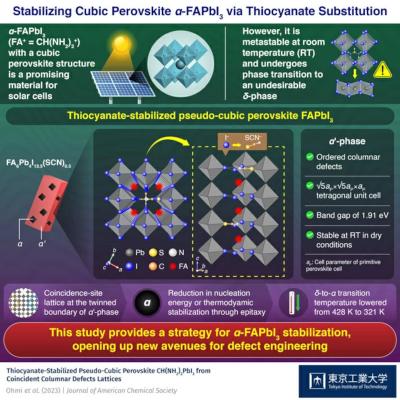Researchers from Japan's Tokyo Institute of Technology, University of Oxford in the UK and Colorado State University in the U.S have shown that α-FAPbI3, a promising solar cell material with a cubic perovskite structure that is metastable at room temperature, can be stabilized by introducing a pseudo-halide ion like thiocyanate (SCN–) into its structure. The recent findings provide new insights into the stabilization of the α-phase via grain boundary and pseudo-halide engineering.
A material with good photophysical properties that has recently gained momentum is α-formamidinium lead iodide or α-FAPbI3 (where FA+ = CH(NH2)2+), a crystalline solid with a cubic perovskite structure. Solar cells made of α-FAPbI3 exhibit a remarkable 25.8% conversion efficiency and an energy gap of 1.48 eV. Unfortunately, α-FAPbI3 is metastable at room temperature and undergoes a phase transition to δ-FAPbI3 when triggered by water or light. The energy gap of δ-FAPbI3 is much larger than the ideal value for solar cell applications, making the preservation of the α-phase crucial for practical purposes. To overcome this problem, the team of researchers, led by Associate Professor Takafumi Yamamoto from Tokyo Institute of Technology (Tokyo Tech), has recently presented a new strategy for stabilizing α-FAPbI3.
The team focuses on the stabilization mechanism of α-FAPbI3 by introducing a pseudo-halide anion, thiocyanate (SCN–). "Previous studies have shown that partial replacement of surface anions of FAPbI3 from iodide (I–) to SCN– ion stabilizes the α-phase. However, it is still unclear how SCN– ions incorporate themselves within perovskite lattice and increase the interfacial stability," explains Dr. Yamamoto.
Single crystal and powder samples of the thiocyanate-stabilized pseudo-cubic perovskite were prepared by the team for the first time. Structural analysis revealed that it has a √5-fold superstructure of cubic perovskite with ordered columnar defects, constituting the α'-phase. The new material was found to be thermodynamically stable in a dry atmosphere at room temperature and exhibited an energy band gap of 1.91 eV.
The team found that the presence of the α'-phase in a sample containing the δ-phase promoted the δ-to-α phase transformation, reducing the transition temperature by over 100 K. They pointed out that the defect-ordered patterns in the α'-phase, that can form a coincidence-site lattice at the twinned boundary, lead to the stabilization of the α-phase, either through a reduction in its nucleation energy or by thermodynamic stabilization via epitaxy.
These insights gained by the researchers could encourage further investigation into the effect of vacancy ordering and defect tolerance on the stability of halide perovskites. "This work shows that α-FAPbI3 can be stabilized through pseudo-halide and grain boundary engineering, which might prove beneficial to scientists trying to develop new thermodynamically stable solar cell materials with ideal band gaps and excellent conversion efficiency," concludes Dr. Yamamoto.




